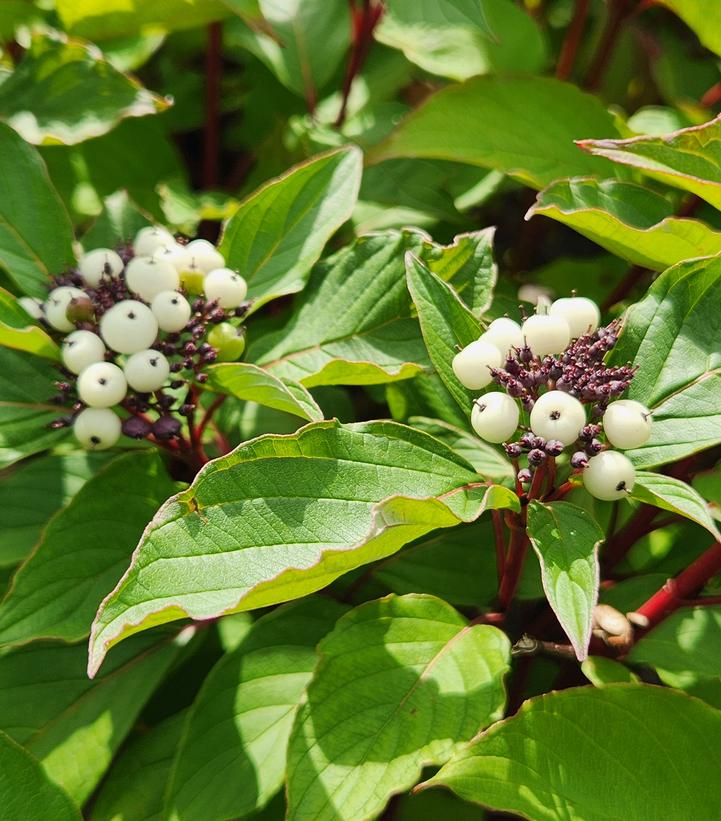Common Name: Red Osier Dogwood ‘Baileyi’
Bloom Time: Late spring to early summer (May–June), with ornamental fruit in late summer
USDA Zones: 2–7 (exceptionally hardy in Southeastern Wisconsin)
Mature Size: 8–10 ft. tall × 8–10 ft. wide
Habit: Multi-stemmed, rounded shrub
Foliage: Green leaves turning red-purple in fall
Winter Interest: Striking red stems visible after leaf drop
Introduction
Few shrubs provide as much four-season beauty as the Red Osier Dogwood ‘Baileyi’. With its clusters of creamy white spring flowers, lush summer foliage, attractive white berries, and fiery red stems in winter, this native shrub is a true all-year performer in Southeastern Wisconsin landscapes. Its adaptability to a wide range of soils—including wet or poorly drained sites—makes it both functional and ornamental.
Heritage Hill Nursery carries the Baileyi Red Osier Dogwood—a reliable, hardy choice for local gardens:
👉 Shop Cornus sericea ‘Baileyi’
Origins & Description
The Red Osier Dogwood (Cornus sericea), sometimes called red-twig dogwood, is native across much of North America. The ‘Baileyi’ cultivar is a particularly vigorous selection prized for its bright red stems that intensify in winter.
In spring, the shrub produces flat-topped clusters of creamy white flowers that attract pollinators. These are followed by clusters of bluish-white berries in summer, which are loved by birds. Fall brings a bold display of reddish-purple foliage, and when the leaves drop, the brilliant red stems take center stage, glowing against snow or evergreens.
The shrub forms a full, rounded shape and naturally suckers, creating dense thickets if allowed—perfect for erosion control or wildlife plantings.
Ideal Growing Conditions (Southeast Wisconsin Focus)
-
Light: Full sun to part shade. Best stem color develops in full sun.
-
Soil: Very adaptable. Prefers moist, well-drained soils but tolerates clay and even wet soils.
-
Moisture: Excellent choice for rain gardens, streambanks, and low spots. Handles seasonal flooding better than most shrubs.
-
pH: Neutral to slightly acidic soils are preferred.
-
Hardiness: Thrives in cold climates, reliably hardy in Zone 2–7.
Planting & Establishment
When to Plant:
-
Spring (April–May): After frost danger has passed.
-
Early Fall (September): Gives roots time to establish before freeze-up.
How to Plant:
-
Dig a hole twice the width of the root ball and the same depth.
-
Place shrub so crown sits level with surrounding soil.
-
Backfill with native soil and water deeply.
-
Mulch 2–3 inches around the base to conserve moisture and suppress weeds.
Spacing: For hedges or screens, plant 6–10 feet apart. For naturalized groupings, allow more room to spread.
Care & Maintenance
-
Watering: Keep evenly moist, especially in the first two years. Once established, it is tolerant of a wide range of conditions.
-
Pruning: To maintain vibrant red stems, remove 1/3 of the oldest stems each spring. New growth has the brightest color.
-
Fertilization: Apply compost or a balanced shrub fertilizer in early spring if soil is poor.
-
Pests & Disease: Generally trouble-free. Leaf spots may occur in wet summers but rarely threaten plant health.
-
Winter Care: None needed; stem color improves in cold weather.
Propagation
Red Osier Dogwood naturally suckers, making it easy to propagate by digging up and replanting young shoots. It can also be propagated by hardwood cuttings taken in winter.
Landscape Uses & Companions
-
Winter Interest: Bright red stems create a stunning winter display, especially against snow or evergreens.
-
Rain Gardens & Wet Sites: Thrives where many other shrubs would fail.
-
Erosion Control: Strong root systems help stabilize slopes and streambanks.
-
Wildlife Habitat: Provides food and shelter for birds and pollinators.
-
Companions: Pair with evergreens like spruce or arborvitae for winter contrast, or mix with other winter-stemmed dogwoods (yellow-twig or orange-twig) for a colorful winter display.
Seasonal Calendar (Wisconsin)
-
May–June: White flower clusters bloom, attracting pollinators.
-
July–August: White-blue berries ripen, feeding birds and wildlife.
-
September–October: Foliage turns red-purple.
-
Winter: Bare red stems provide dramatic seasonal color.
Troubleshooting
-
Sparse Stem Color: Prune out old stems regularly to encourage fresh red growth.
-
Excessive Spread: Thin or prune suckers to maintain desired shape.
-
Leaf Spots: Occasional in wet weather, but not serious.
Ecological & Garden Value
-
Pollinator Friendly: Flowers attract bees and butterflies.
-
Bird Habitat: Berries provide late-summer food, while dense branching offers nesting cover.
-
Soil & Water Benefits: Ideal for stabilizing banks, filtering runoff, and supporting wetland ecosystems.
-
Four-Season Beauty: Flowers, berries, fall foliage, and winter stems ensure year-round appeal.
Ready to Plant?
If you’re looking for a hardy, versatile shrub that shines in every season, the Red Osier Dogwood ‘Baileyi’ is a must-have. Its resilience, ecological value, and stunning winter color make it a standout for Wisconsin gardens.

